Roger continued to work for the Griffith Observatory, where he constructed a model of Oregon’s Crater Lake and another of the Arizona Meteor Crater. Following this work he was hired by the Adler Planetarium in Chicago to construct another model of the moon, this time only 6 feet in diameter, and according to Roger “a frightful chore.” Roger was approached for illustration work on a proposed astronomy history book, The Round World with E. T. Bell, but the project was abandoned following a lull in correspondence. He also built for Betty her first loom, a craft in which she engaged with enthusiasm for the rest of her life.
Later in 1936 and 1937, Roger was hired by the California Walnut Growers Association to develop a nut cracking machine for the mass processing of nuts. Roger was paid well for his work, but the design proved unsuccessful during final testing. Later in life he suggested that the failure was in large part caused by a disgruntled manager who wanted a different design and thus deliberately ran Roger’s machine to destruction during its demonstration. Regardless of the final outcome, Roger viewed his work on the device in a positive light:
“I am sorry to say it was a flop. I still believe the idea was pretty good, but the model machine was pretty rough on the nuts and turned out first-class nut meal. The Machine had one real virtue – it saw me through a bad hole in the Depression.”
Roger’s general interest in astronomy continued to strengthen, and he kept up regular attendance at One-Hundred-to-One Shot Club meetings. He received his California State Architectural Practitioner’s Certificate and continued his membership in the Southern California Chapter of the American Institute of Architects. Though he maintained a connection to Sam Lunden’s office with occasional assignments, Roger’s only significant architectural work near the end of the decade was as a designer and consultant for the University of Southern California’s Allan Hancock Foundation Laboratory.

Loom designed and built by Roger Hayward, ca. 1935-1936. More images here

